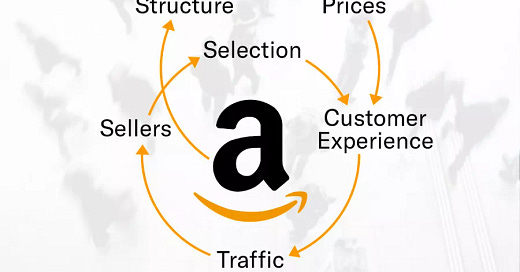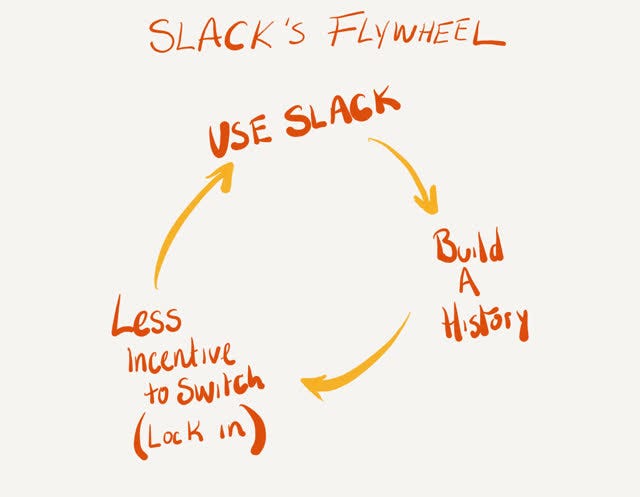The Sneaky Flywheel Strategies Behind Your Favourite Brands
How Amazon, Uber, and Airbnb grew so big, so fast
Ever wonder how companies like Amazon, Uber, and Airbnb grew so big, so fast? The secret lies in an ingenious concept called the flywheel effect.
Flywheels are self-reinforcing loops that compound growth. Companies spark flywheels by linking together customer actions and business offerings in a mutually boosting cycle. Small motions gain momentum over time through the flywheel's virtuous circle.
Let's explore the flywheel models that propelled today's giants to success.
Amazon’s Flywheels of Scale
Amazon dominates ecommerce thanks to not one but multiple flywheels that feed off each other:
The marketplace flywheel – Amazon invites third-party sellers onto its marketplace. This vastly expands product selection, drawing more customers. More customers lure more sellers, boosting selection further. Greater profits fund services like Prime and Fulfillment, attracting more shoppers and sellers. The cycle repeats, the flywheel accelerates.
The Prime flywheel – More marketplace sellers and first-party selection entice shoppers to buy Prime for free shipping. Prime's conveniences hook them into visiting and buying more frequently. More Prime signups strengthen Amazon's leverage over suppliers, enabling new perks like streaming. This cements user loyalty and fuels flywheel momentum.
Through these complementary flywheels, Amazon enjoys powerful cycles that leverage its strengths.
Uber’s Rider-Driver Flywheel
Uber grew from nothing to billions in rides through a flywheel hinging on supply and demand.
Uber lures ridesharing drivers via sign-up bonuses and flexibility. More drivers reduce pickup times, improving rider satisfaction. Happier riders take more trips, boosting driver earnings. Satisfied drivers stay active on the platform. Shorter wait times attract more users. The cycle repeats, scaling rapidly.
This elegant rider-driver flywheel lets Uber expand with minimal capital outlay. Each side reinforces the other in a sustainable loop. Lower wait times translate into higher earnings for all players.
Airbnb’s Host-Guest Flywheel
Airbnb similarly brings together two sides - hosts and guests - in a reciprocating flywheel.
Guests attract hosts by promising occupancy revenue. More listings improve selection, driving guest signups. Guest demand entices more hosts. Growing options and reviews build guest trust and loyalty. The cycle repeats and the platform grows.
This host-guest flywheel lets Airbnb scale bookings and revenue without owning properties. The users themselves power growth, with each side incentivizing the other.
Dropbox’s Storage Flywheel
Dropbox offers free storage to prime its flywheel. Users sign up and store files in the cloud. As their networks join, file sharing cuts across accounts, creating collaborative value.
The more users store, the more utility everyone derives. Dropbox improves features using subscription revenue enabled by a sizable user base. Enhanced functionality draws in more customers.
This elegant storage flywheel allows Dropbox to scale customers before large outlays on infrastructure. The service becomes stickier as users embed it in daily workflows.
Slack’s Organic Flywheel
Slack spreads like wildfire thanks to viral loops inside teams. Adoption often starts for free with just a few users. Peer influence leads whole teams to sign up as members urge others to join.
As organizations realize Slack's collaborative power, they upgrade to paid plans. Revenue funds platform advancement and sales support. These enhancements draw in more organizations for the cycle to continue.
Organic sharing enables Slack's rapid uptick rather than costly acquisition. The more users, the stickier the product thanks to network effects.
Houzz’s Content Flywheel
Home improvement site Houzz attracts users via engaging lifestyle content. Visitors provide data to improve ad targeting precision for buyers.
Growing audiences let Houzz enhance content. More content draws more consumers. The cycle restarts with each rotation expanding Houzz's reach and value.
Superior content makes the platform more enticing. Houzz then monetizes audiences through transactions enabled by precise matching.
Flywheels Unlocked
As these examples showcase, flywheels are a powerful force multiplier for growth. Smart businesses design flywheels strategically to capitalize on inherent growth loops. Linking users, assets, or steps that mutually enhance each other creates an ever-accelerating cycle with massive benefits.
With creative thinking, you can engineer your own repeatable, sustainable wheels to drive your business' growth into the future.




